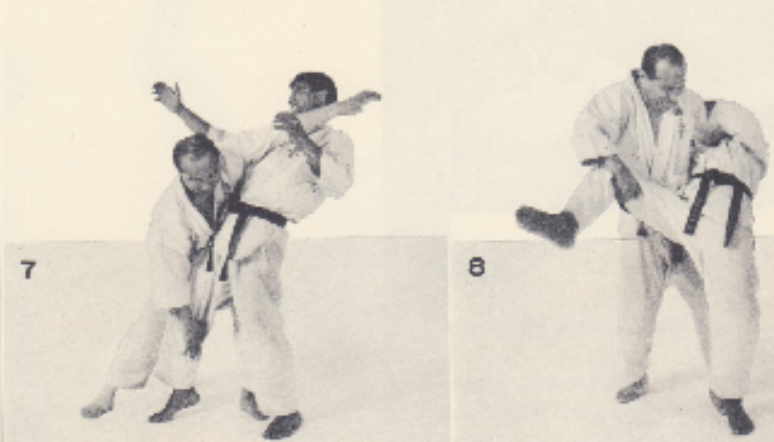This strange set begins with a double forearm block and then a transition to a reverse low block. It looks like a scissor block, and I've seen many students perform a scissor block (crossing the arms to setup), but technically isn't one because the instructions are to keep the left forearm "in the same place". The Encyclopedia of Taekwon-Do confirms this: the performer does not cross his arms.
This makes the interpretation of the movement more narrow.
The first understanding has to be how to apply the double forearm block in this instance. One common application is from the front like so:
Striking the inner-elbow and side of the neck simultaneously.
But in sections from the Heian/Pinan kata, the block appears to be applied from behind the opponent. The supporting hand grasps an arm while the front arm attacks the back of the head. The below image is not the same technique, but same position.
 |
| Applying a kata technique from behind an opponent. Source: Goju-Ryu Karate-do |
How did we get behind the opponent? I believe the previous movement in the pattern, the moving backwards into a knifehand guarding block, may be applied as a head crank throw. We use this set if the opponent turns their body along with their head, which negates the throw but places us behind them.
The opponent may defend against the strike by dodging their head forwards, so instead we are going to attack the back of their leg with the low block. Although the instructions are to keep the left forearm in the same place, in practice I would grab and and keep ahold of the back of the opponent's shirt.
 |
| Source: One-minute bunkai |
As you can see, this technique can be enough to throw the opponent if we add in a pull and drop.
But in the pattern we step forward into the lunge punch. We use this to transition to a single leg takedown (perhaps if we fail to throw the opponent this way), meaning we use the "punch" as a crude lifting of the leg with our forearm. We turn turn around and hold up the opponent's leg with our reverse knifehand.
 |
| A similar idea from Mas Oyama's book Advanced Karate (1970) |
 |
| Reverse knifehand block application |
After holding up the leg with the reverse knifehand, we place the opponent's ankle on our shoulder and use closed ready stance C to push into the opponent's knee, throwing them with a knee lock.
 |
| Source for left images: Effective Martial Arts |
I admit this application does not completely satisfy me (it involves a lot of steps), but it may be used to teach students a single-leg takedown that is not, to my knowledge, in any other ITF patterns.



No comments:
Post a Comment